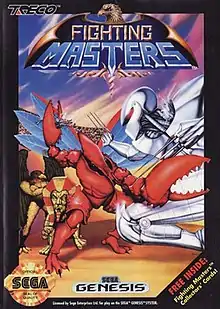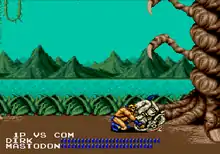Fighting Masters
Fighting Masters[lower-alpha 2] is a 1991 fighting video game developed by Almanic Corporation, in conjunction with Aicom and ALU, and published for the Sega Genesis in Japan and later in North America by Treco. In the game, players assume the role of a hero to fight against an assortment of opponents on a apocalyptic setting to face against an entity known as Lord Valgasu. Co-directed by Hajime Kusano and Ramō Kobayashi, the title was created by some of the same team that would later work on various projects at Almanic such as E.V.O.: Search for Eden. It was met with mixed reception from critics since its release.
| Fighting Masters | |
|---|---|
 | |
| Developer(s) | Almanic Corporation[1][lower-alpha 1] |
| Publisher(s) | |
| Director(s) | Hajime Kusano Ramō Kobayashi |
| Producer(s) | Robb Alvey (Uncredited) |
| Designer(s) | Masahiko Ujita Yasuo Wakatsuki |
| Programmer(s) | Toshiyuki Nishimura Yazawa |
| Artist(s) | Masami Takizawa Naoyuki Hayakawa T. Shigemura |
| Composer(s) | Hiromitsu Shioya Masaki Kase |
| Platform(s) | Sega Genesis |
| Release | |
| Genre(s) | Fighting |
| Mode(s) | Single-player, multiplayer |
Gameplay

Fighting Masters is a fighting game where the player fights against other opponents in one-on-one matches and the fighter who manages to deplete the health bar of the opponent wins the bout, becoming the winner of the match.[3][4]
In single-player mode, players can choose from twelve playable characters and fight against computer-controlled fighters. Three buttons are available in the game: block (A), attack (B) and jump (C).[3][4] The d-pad cannot be used to jump directly, instead, players have to walk in a certain direction and press the jump button to perform said action. The attack button allows players to perform various attacks, special moves and combos. Besides the single-player mode, other modes include matches against another human opponent or a watch mode to view a fight between two CPU-controlled opponents.[3]
Synopsis
Plot
Fighting Masters takes place in a pre-apocalyptic universe, where an enormous red sun is about to go supernova within hours, leading representatives from multiple alien races to fight against each other to gain trust and service of an ultra-intelligent race known as Primaries, who will grant another galaxy to live in for them and their future generations.[3][4] However, the in-game plot tells a different story involving a demon lord known as Lord Valgasu, who leads an underground campaign against a twelve-star galaxy to take control of it, conquering all of the stars' rulers and making them his slaves except one.[5] Assuming the role of a lone hero, the player battles against the enslaved rulers and Valgasu himself.
Characters
Some of the character's names were changed between the North American and Japanese releases:[3]
|
|
Development and release
Fighting Masters was created, alongside with Aicom and ALU, by some of the staff members that would later work on various projects at Almanic Corporation such as E.V.O.: Search for Eden for SNES.[1][2][6] Both Hajime Kusano and Ramō Kobayashi assisted as directors, with Taito's Superman director Toshiyuki Nishimura and a member under the pseudonym of "Yazawa" serving as programmers.[6] Masahiko Ujita, Masami Takizawa, Naoyuki Hayakawa, T. Shigemura, Toshiyuki Nishimura and Yasuo Wakatsuki acted as artists and designers respectively.[6] Both Masaki "Masapi" Kase and Hiromitsu Shioya worked as sound designers.[6]
Fighting Masters was first released in Japan on December 6, 1991 and later in North America on April 1992 by Treco.[7][8] The game was also released on South Korea by Samsung in 1992.
Reception
| Publication | Score |
|---|---|
| CVG | 91%[9] |
| GamesMaster | 65%[10] |
| Beep! MegaDrive | 6.5/10[11] |
| Consoles + | 72%[12] |
| Entertainment Weekly | B+[13] |
| Games-X | |
| Génération 4 | 84%[15] |
| Hippon Super! | 70/100[16] |
| Joystick | 82%[17] |
| Mean Machines | 81%[18] |
| Mega | 50%[19] 20%[20] |
| Mega Drive Advanced Gaming | 44%[21] |
| MegaTech | 86%[22] 84/100[23] |
| Power Play | 17%[24] |
| Sega Pro | 66/100[25] 30%[26] |
Entertainment Weekly gave the game a B+, writing that "As artlessly crowd-pleasing as a Golden Gloves tournament, this high-energy slugfest has you sparring with, and stepping into the ring as, a motley assortment of aliens (my faves are Dio, a head-chomping carnivorous plant, and Rotundo, who looks like a cross between the Michelin Man and George Foreman). The battles are quick, they're vicious, and they're over fast — which alone gives Fighting Masters an easy TKO over its video-game competition."[13] Video game magazine Mega gave the game a score of 20% in their December 1993 issue.[20] AllGame gave it a rating of 3 stars out of a possible 5.[27]
References
- "Company Profile: Almanic Corp". GameSpot. CBS Interactive. 2008. Archived from the original on 2010-08-22. Retrieved 2020-08-14.
- "コンシューマーゲームソフト". ALU (in Japanese). D3 Publisher. 2003. Archived from the original on 2004-06-19. Retrieved 2020-08-14.
- Fighting Masters instruction manual (Sega Genesis, US)
- Thornburg, Vince (February 22, 2007). "Genesis Reviews - Fighting Masters". sega-16.com. Archived from the original on 30 December 2019. Retrieved 2020-08-14.
- Almanic Corporation (1992). Fighting Masters (Sega Genesis). Treco. Level/area: Introduction.
- Almanic Corporation (1992). Fighting Masters (Sega Genesis). Treco. Level/area: Design Staff.
- "ソフトウェア一覧(ソフトライセンシー発売)| メガドライブ". SEGA HARD Encyclopedia (in Japanese). Sega. 2020. Archived from the original on 2020-06-26. Retrieved 2020-08-14.
- "Around The Corner". Sega Visions. No. 8. Infotainment World. May–June 1992. p. 56. Archived from the original on 4 April 2016. Retrieved 14 August 2020.
- Boone, Tim (February 1992). "CVG Review - Fighting Masters". Computer and Video Games. No. 122. EMAP. p. 36. Retrieved 2019-05-11.
- "Reviews - Fighting Masters". GamesMaster. No. 14. Future Publishing. February 1994.
- "BEメガドッグレース – ファイティングマスターズ". Beep! MegaDrive (in Japanese). No. 28. SoftBank Creative. January 1992. p. 77.
- Hermellin, François (January 1992). "Megadrive Review - Fighting Masters". Consoles + (in French). No. 5. M.E.R.7. pp. 30–31. Archived from the original on 8 September 2017. Retrieved 14 August 2020.
- Strauss, Bob (June 12, 1992). "Fighting Masters". Entertainment Weekly. No. 122. Meredith Corporation. Archived from the original on 7 September 2018. Retrieved 2020-08-14.
- "Console Connexions - Reviews: Fighting Masters". Games-X. No. 36. Europress. January 2–9, 1992. p. 22.
- "Console Test - Fighting Masters". Génération 4 (in French). No. 40. Computec Media France. January 1992. p. 141.
- "TV Game・Broad-Way: ファイティング マスターズ". Hippon Super! (in Japanese). No. 13. Takarajimasha. January 1992. p. 93.
- Franck (January 1992). "Consoles News - Fighting Masters". Joystick (in French). No. 23. Anuman Interactive. p. 133.
- Rignall, Julian; Automatic, Radion (February 1992). "Megadrive Review – Fighting Masters". Mean Machines. No. 17. EMAP. pp. 88–90.
- "Street Fighter 2: And in the Red Corner... - Fighting Masters". Mega. No. 10. Future Publishing. July 1993. p. 33.
- "Mega Retro: One-On-One Beat-'Em-Ups - A Brief History Of Crime". Mega. No. 15. Future Publishing. December 1993. p. 77.
- "Review: Fighting Masters". Mega Drive Advanced Gaming. No. 3. Maverick Magazines. November 1992. p. 79.
- Patterson, Mark; Glancey, Paul (February 1992). "Review: Fighting Masters". MegaTech. No. 2. EMAP. pp. 54–55.
- "Megadrive Review: King of the Monsters - Alternatively". MegaTech. No. 17. EMAP. May 1993. p. 51.
- Weitz, Volker (May 1992). "Videospiele / Tests - Fighting Masters". Power Play (in German). No. 50. Future Verlag. p. 148.
- Butt, Damian (April 1992). "ProReview: Fighting Masters". Sega Pro. No. 4. Paragon Publishing. p. 65.
- "The Profile: Mega Drive - Fighting Masters". Sega Pro. No. 18. Paragon Publishing. April 1993. p. 65.